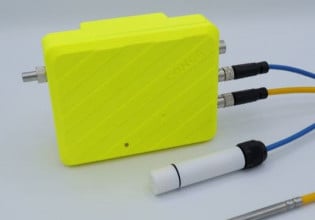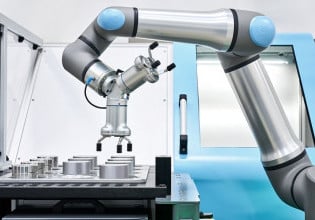Voltages of Devices in AC Circuits
This article explores resistors, capacitors, and inductors when it comes to AC applications and how voltage is affected in circuits using these components.
The differences in AC and DC electricity are usually only visible behind the scenes — that is, in properly designed circuits, the devices will appear to have similar behaviors and outcomes. However, a closer look will reveal two entirely different systems yielding some interesting (and often very problematic) characteristics.
The name of the two different voltage systems — direct current (DC) and alternating current (AC) — describes in rough terms their chief difference. AC alternates directions, while DC carries on a path directly from + to -, in conventional terms.

Figure 1. A solenoid valve uses AC power.
Although it seems simple enough, that concept of alternating directions causes extreme differences between the two systems. The devices, circuits, effects on the environment, and the mathematics are all different.
Previously, there has been some discussion of voltage drops in DC circuits. These articles examined the effects of a resistor on the voltage supply to a circuit, and a further article to explain the time variation seen in the voltage of a capacitor and inductor. When it comes to AC applications, the devices change their effect even further.
Resistors in AC
All components have some resistance to electrical flow, but some will exhibit the characteristics of a resistor almost entirely. A good example of this kind of device is the braking resistor which is commonly built into a motor stopping circuit.

Figure 2. A braking resistor cabinet. Image courtesy of CP Automation, Ltd.
Resistors will begin dissipating energy the moment current begins passing through them, and will cease to dissipate energy when current stops. Unlike with other components, there is no delay between the applied voltage and the power dissipation. The only delay might come in the form of how long it takes for the heat to begin radiating to the outside of the component.
This instant response means that in DC circuits, the resistor will measure its respective ‘steady-state’ voltage the moment the circuit is completed. In an AC circuit, the voltage would appear to rise and fall at the frequency of the circuit (most likely 50 or 60 Hz). Measuring this quantity on a DC voltage setting would attempt to display the instantaneous voltage at every measurement. Since it’s changing, the displayed voltage would also seem to be jumping around constantly.
Capacitors in AC
A simple description of capacitors in AC would state that the resistance (and therefore voltage) of a capacitor would drop based on the frequency NOT the source voltage. But if the voltage source provides a certain potential for energy to be used, why would a constant source voltage yield a different load voltage simply by varying the frequency?
In a DC circuit, the energy required to build the charge on opposite sides of the insulator will increase over time as the voltage remains. If the voltage is applied, but then very quickly removed, the energy dissipation will be very small. Since voltage is directly related to energy dissipation, this will lead to a small drop in voltage.

Figure 3. Industrial AC single-phase motors contain a large capacitor.
If the frequency is high, this quickens the application and removal cycling of voltage, lowering the maximum voltage that could be seen across the capacitor. The average (or more accurately RMS) voltage will then be lower for higher frequencies. This causes an effective decrease in the resistance to current flow.
This low resistance at high frequencies is the primary reason that serial communication lines (like USB and RS-232) cannot exceed short distances. The capacitance between the cables in the bundle will cause current between wires for high-frequency data switching.
Inductors in AC
Since inductors have roughly the opposite effect on voltage from capacitors in DC, it should be expected likewise that the voltage in AC will behave in the opposite manner. In a DC circuit, the immediate application of source voltage must provide a lot of energy to build up a magnetic field in the core of the coil. As the magnetic field builds, it requires less energy to continue building, eventually reaching a fully ‘charged’ core, and no more energy is required.
In voltage terms, that initial inrush and dissipation of energy yields a high voltage. The voltage of the inductor will be equal to the source voltage right at the beginning. As the energy requirement fades, so does the voltage.
It does not, however, reach zero volts. Every inductor has some amount of actual resistance, not purely inductance. The voltage may drop to a minimum value over time, but not zero volts.
Looking at the effect in an AC circuit application, we can make similar statements. If the voltage is rising and falling very rapidly, the energy input never exists long enough to build the magnetic field, so the voltage will stay quite high. This happens when the frequency is high in an inductive circuit - there will be a larger voltage drop across the inductor, and we can say that the effective resistance to current is also high.
As the frequency drops, it would seem that the voltage drop of the inductor would also drop eventually to zero volts once the magnetic field was fully developed and required no further energy. However, since there is always some resistance in an inductor coil due to the thin wires, it should be expected that an inductor’s voltage will NEVER become completely zero ohms.






